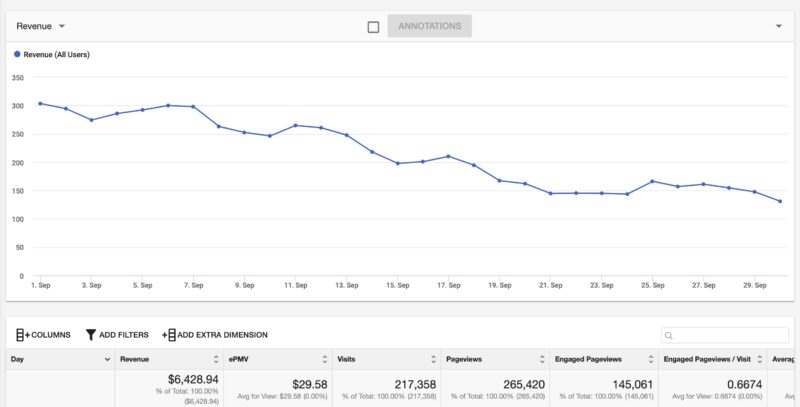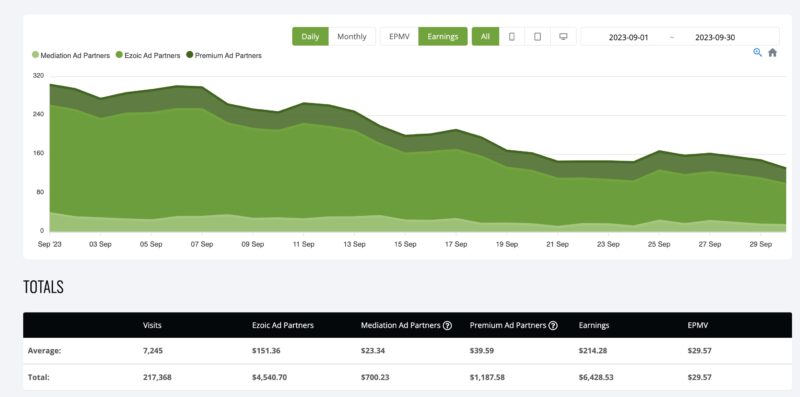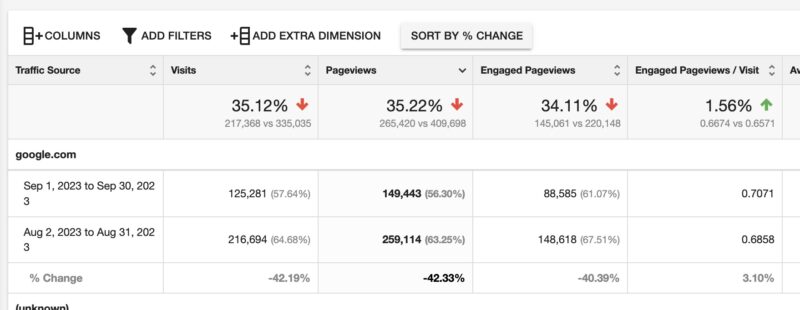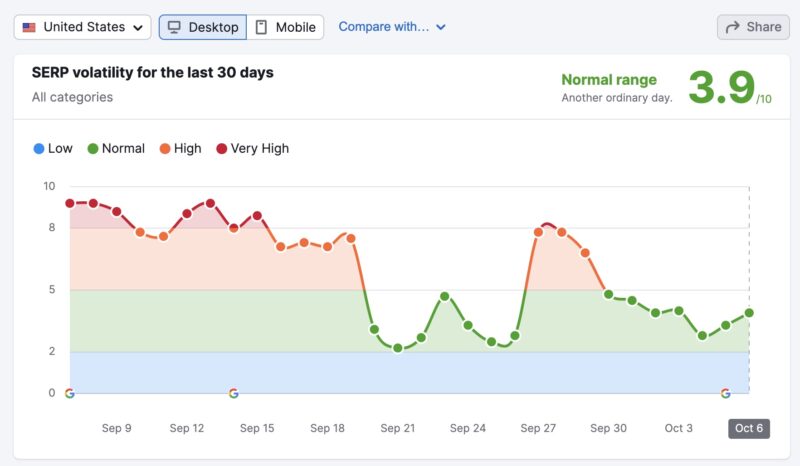In the past several updates, we’ve mentioned numerous challenges that have suppressed our case study domain’s monthly ad revenues. It mostly boiled down to the general slump in the display ads market, as well as Google’s Core algorithm updates wrecking the SEO strategy that we’ve built over the past two or so years. In this case, we can see now that the latter has become a far greater variable to account for.
To begin with ripping off the band-aid as early as possible, September 2023 saw our case study domain’s monthly ad revenues drop to a new low of $6,428. This was in stark contrast to the five-digit monthly ad revenues that we’ve been earning since December 2021, when we first crossed that threshold. Even if we are to compare it against August 2023, it’s still a massive (roughly) 28.19% drop in monthly earnings.
The total was slightly balanced out by an increased EPMV (earnings per thousand visitors) compared to the previous month, of around 10.68% (from $26.72 to $29.58). It does show that, at the very least, the global display ads market was on the verge of slowly recovering. Nonetheless, we’re then immediately pulled back into the red when you look at September’s brutal site traffic for our case study domain.
Page visits are down by 35.12% (217,358 vs 335,010), while pageviews are also down by a close 35.22% (265,420 vs 409,698), whereas ‘engaged’ pageviews had declined by 34.11% (145,061 vs 220,148). With that in mind, what’s caused this issue, in the first place? Well, if you’re a fellow publisher with an entire site dedicated to an SEO-optimised and SERP-focused content strategy, you might’ve noticed it, too.
| September 2023 Ad Revenue From Ezoic | ||
|---|---|---|
| Revenue (Total) | $6,428 | |
| Traffic | Visits | 217,358 |
| Pageviews | 265,420 | |
| Engaged Pageviews | 145,061 | |
| ePMV (Earnings Per Thousand Visitors) | $29.58 | |
Why Such Massive Drop-Offs In Traffic?
If you’ve noticed drops in site traffic and lower search rankings in Google’s SERP for your site too, it could be best summarised with two words; “Helpful Content”. This was what Google penned their latest Google Core search engine algorithm updates, which began taking shape some time ago. The very first mentions of Google’s new Helpful Content system began sometime around September and October of 2022.
Not coincidentally, that was when our case study domain first saw a gradual decline in site traffic. But, it wasn’t radical enough just yet, as Google continued rolling out these Helpful Content guidelines through early and mid-2023. However, it wasn’t until the August and September 2023 (not counting the recently announced October) Core updates that it took effect, and majorly impacted publications like ours.
So, what are these “Helpful Content” guidelines, anyway? To put it simply, this was Google’s way (using their AI-based algorithms and human Quality Raters) of determining just how helpful and valuable a site is. Google’s priority with their SERP (search engine results page) rankings is to now prioritize sites that deliver answers that searchers want to look for in the most concise and efficient way possible.
For example, if a searcher on Google searched for “how much is the new iPhone”, a site that can speedily deliver the answers clearly and thoroughly would have a better chance of ranking (and also matching the search intent well – that is, informing the reader on the cost of the new iPhone), when compared to a site that buries the answers under large blocks of irrelevant text, making it harder to read at a glance.
Why Is Google Doing This?
To summarise once again, Google’s new priority for sites to rank well in its search results, are those sites that can match the user’s search intent and provide whichever answers they sought for in a presentation that’s easy to read at a glance and simple to find. Using this new “Helpful Content” methodology, Google has been keen on removing spammy or unconcise content off their search engine results page.
In addition to providing the most concise answers or summaries possible, Google’s last few Core updates have also put a heavy emphasis on factors such as E-E-A-T (Experience, Expertise, Authoritativeness, and Trustworthiness). Therefore, Google is also assessing the authoritativeness of the website and its authors, and whether or not the writer of an article has the experience or expertise to answer specific topics.
For instance, a computer repair service website (which also happens to run its own blog) might rank a bit better compared to a tech blog, whenever users are searching for how to repair a broken PC. When it compares to Google’s E-E-A-T, the former (a computer repair service site) has the authoritativeness to speak about computer repairs, given their day-to-day experiences, expertise, and customer trust.
This is also the reason why you might’ve noticed that community-based sites like Quora and Reddit have been ranking higher than usual in Google’s search results lately. Once more, Google is looking at E-E-A-T, and in the case of the latter two, most folks on Quora or Reddit (not to mention forums, as well) typically have some sort of first-hand experience, and can display a degree of expertise with any specific topics.
What Should We Do Now?
Speaking of, if you’d like to learn more about how SEO works, do check out our guide on how to properly do keyword research, as well as our list of the best free keyword research tools, on top of our detailed on-page SEO checklist. For additional insights beyond the free resources that you’ll find here, like my in-depth guide on making money online from content creation websites, we have a paid training course.
But going back to SEO, Google’s new Helpful Content guidelines go entirely against our tried-and-tested SEO strategy that has worked so well up until since. As you may know, if you’ve read our past monthly ad revenue reports, then you may be familiar with our content format and strategy; long-form, 3,000-word, SEO-focused, and keyword-optimised articles.
However, it seems like Google now prefers if our articles are a tad shorter (perhaps as little as just 1,000 words long), with the answers that searchers are looking for made abundantly clear. Furthermore, even secondary keywords and the expansive inclusion of links in our case study domain articles have become much less of a priority, especially when compared to the conciseness of the general structure.
These changes that we need to do are vital, given that most of our case study domain’s site traffic comes from google.com. According to Ezoic’s Big Data Analytics page, about 60% or so of our site traffic is from Google. Therefore, competitive search page rankings there will make a huge difference. There’s already a lot of volatility in Google’s SERP, and more so now that the September Core updates begin kicking in.
Future Plans And Video Overview
Still, on the bright side, at least we chose Ezoic to be our preferred ad network provider for our case study domain. Their clever AI placeholders and countless other neat tech and systems have no doubt worked a miracle in at least offsetting some of these heart-breaking losses. If you’d like to learn more, check out our guide on how to get started with Ezoic, and how to optimize Ezoic for maximum ad revenue.
For us, in the short term, our case study domain will have to go through some re-orientation, and what’s most likely, is an enormous change in how we craft content and articles going forward. In addition, we’ll have to look at what to do with our older, pre-Helpful Content articles, as well, and see what could be done with those. Could we re-optimize our extensive bank of existing content to meet the new SERP?
Alas, we don’t have all the answers just yet, though we do have a solid strategy and an understanding of where to go from here. It’s certainly an interesting and experimental period that we’re in now, so for our fellow publishers who’ve suffered downturns, fret not, as we aim to have more updates in next month’s report, and possibly with better news. For now, check out our video overview below to learn more…








